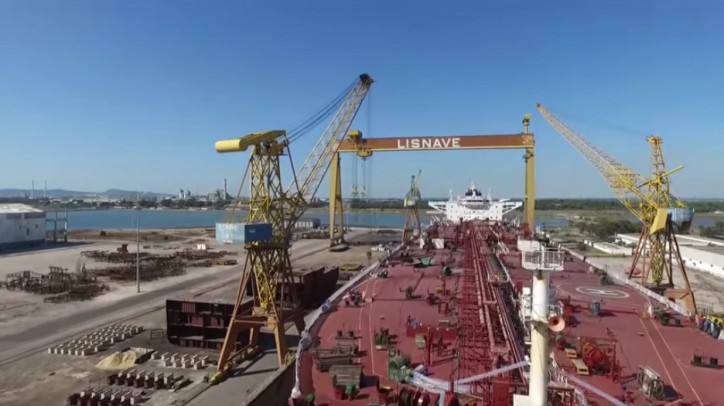The process of dry-docking refers to when a vessel is taken to the service yard and brought to dry land so that submerged portions of the hull can be cleaned and inspected. This work is both preventative as well as a regulatory requirement within the industry. When second-hand purchased vessels are due for dry-docking, they are rebranded and assessed to meet all Teekay standards.

At Teekay, vessels are scheduled for dry-docking once every five years, with intermediate surveys taking place in between. Once the vessels are put back into service, they are more eco-friendly and fuel-efficient. If the world of dry-docking had one moto, it would be “plan, plan, plan and plan some more.”
In 2015, the Teekay Tankers team completed the largest dry-docking program to date, successfully processing 17 vessels over the course of 382 days of service time. The process itself requires careful planning and preparation. Every minute detail needs to be taken into consideration when undertaking a major project such as the dry-docking of a vessel – and even more so when trying to coordinate 17 of them in a year.
So what does the actual dry-docking process entail? Let’s have a look:
Arrival at Yard and Entering the Dry-dock
After completing all necessary preparatory work, the vessel arrives at the shipyard. On completion of port formalities, the vessel proceeds to the dry-dock with assistance from tug boats and shipyard personnel. Prior to this, the blocks are arranged by the shipyards as per each vessel’s specific docking plan.
Pumping Down the Dock and Vessel “Taking” the Blocks
The water is drained from the dry-dock (generally overnight) over the course of about eight to ten hours, depending on the size of the vessel. Before the vessel is rested on the block, specialized dive teams ensure the block structures are in the correct location.
Ranging the Cables
The cables (or anchor chains) are ranged on the dock bottom once the dock is dry. Anchors and cables are then inspected and measured to determine the quality/ condition and defective parts are repaired or replaced as required.
Hull Painting
The hull painting consists of washing, blasting and painting of the vessel and is one of the main reasons for dry-docking, as it ensures efficient vessel operations for the next five years. After extended periods of sailing and service, it is not uncommon for marine growth such as algae or slime to build up on the sides of the vessel. This buildup has a direct impact on the efficiency of the vessel and ultimately leads to higher fuel consumption.
Washing
Shipyard personnel use (fresh water) high-pressure washers to remove marine growth and chlorides from the ship side.
Blasting
Blasting is done primarily to remove rust or defective paint from the ship side. Depending on the need of each vessel, blasting may be localized or carried out along the entire side of the vessel. In this process, old paint in the defective areas is removed entirely to expose the bare steel.
Painting
Once the blasting is completed, the entire vessel is cleaned and painted to protect the integrity of the steel and prevent future corrosion. The underwater side is painted with anti-fouling paint to prevent marine growth and ensures vessel operates close to its original design speed and fuel consumption.
Opening Sea Chests and Overhaul of Sea Valves
The sea chest is a recess in the hull of the ship that provides intake of sea water for the cooling systems in the engine room. This area is opened during the dry-docking process for cleaning, inspecting and painting. At the same time, all ship-side sea valves are inspected and overhauled as required.
Necessary Repairs and Maintenance
During this period, teams take the opportunity to carry out maintenance work on engines, pumps, tanks and cargo spaces as needed. Repairs on the rudder, propeller or shafting are made if any defects are identified.
Flooding the Dock
After all planned work has been satisfactorily completed, the dock is flooded and prepared for the vessel’s departure.
Departure and Trials
The vessel is towed out of the dry-dock with the assistance of tugs and shipyard personnel. Once the vessel reaches a safe anchorage area, sea trails are carried out to confirm the operation of all ship’s machinery. On completion of sea trials, the vessel is commissioned back into service.
Source: Teekay